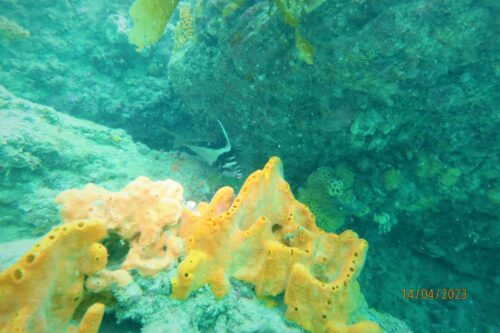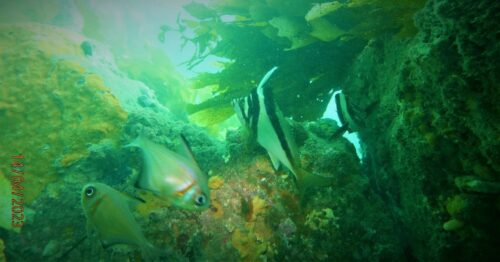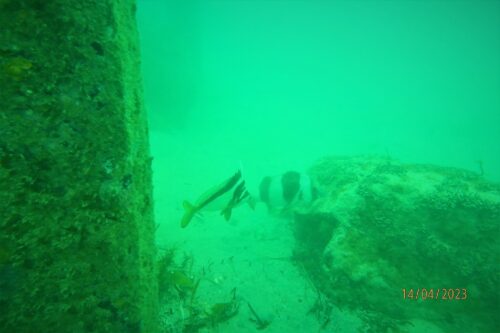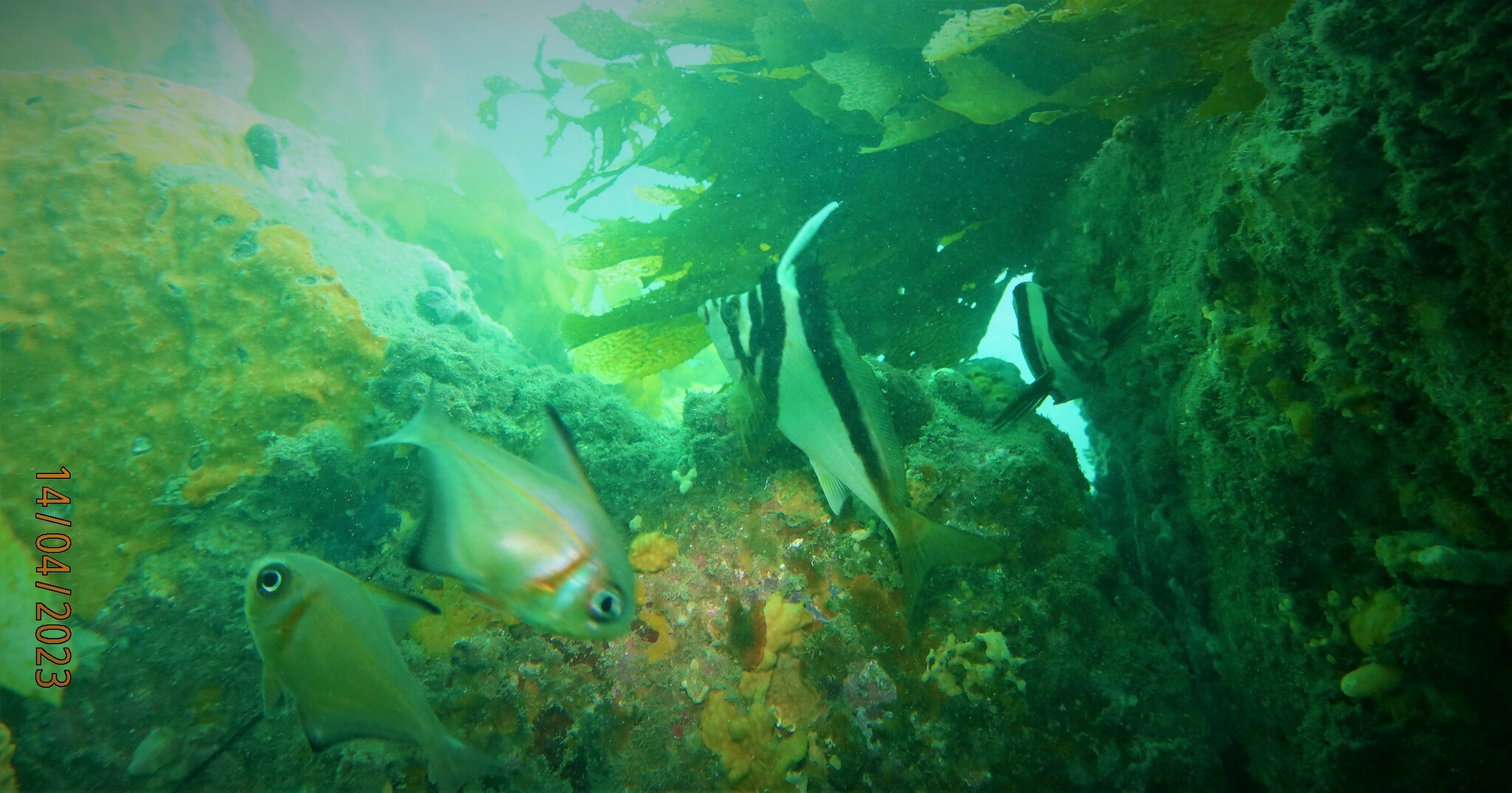To quote Sara Criddle from Facebook, “It’s still there!” I refer to the Western Crested Morwong, Goniistius gibbosus (aka WA Magpie Morwong), that has been sighted at Port Noarlunga jetty and reef this year.

As I reported in Observations made during our recent dive at Port Noarlunga Reef, “Western Crested Morwong were previously not recorded in SA waters. As the name suggests, they were only seen in southern WA. Their sudden occurrence in SA is a huge range extension for the species.”
Lauren Cameo’s video footage taken at Port Noarlunga earlier this year features a Western Crested Morwong at just after the 1-minute mark.
This photo is a still taken from Lauren’s video footage: –

Reports of sightings of the fish deserve an article of their own, one focused solely on those sightings. Several divers have reported seeing the Western Crested Morwong at Port Noarlunga in the past three months. David Muirhead was able to get some stills and video footage of one during our most recent dive there on 14th April. He has posted some of his photos to iNaturalist.

David’s sighting and subsequent photos are what spurred me to revisit this subject. Here are some of David’s comments: –
“Poor visibility hampered imaging but, more importantly, this fish was fast and flighty, surprisingly so given its relatively low-risk location i.e. outgoing weak (‘dodge’) tide, and the relaxed generally approachable behaviour of many of the more common reef fishes at this site.
“It zoomed about in depths from ~4m to ~7.5m, stopping quite often, but only briefly (perhaps seeking a clean from the many western cleaner clingfish and other host cleaner fish observed there).”
“First record for Gulf of St Vincent and previously largely confined to SW Western Australia. Clearly yet another case of range extension due climate change …..”
This photo taken by David Muirhead shows the Western Crested Morwong (aka WA Magpie Morwong) seemingly thinking that it is actually an SA Magpie Morwong (aka Magpie Perch): –

David has also reported a few other recent surprise sightings: –
“Just within the last few years all sorts of local surprise ‘arrivals’ have been hitting the marine biodata sites like iNaturalist/ALA.
#1: Red Snapper under Rapid Bay jetty (I’ve NEVER seen one in Yankalilla Bay, and the species is in overall decline in SA due overfishing, etc.. but maybe its other name, Bight Redfish, is a clue. The greatest densities before commercial and recreational targeting were in the relatively warm temperate Great Australian Bight, hmm… (but the Rapid Head Green Sanctuary Zone is a possible confounding factor).
#2: the Magpie Morwong as above.
#3: Lots more juvenile Southern Blue Devils than usual in living memory in places like Second Valley and Rapid Bay.
#4: Big Luderick are now often seen in Gulf of St Vincent e.g. Rapid Bay jetty, and for decades they were generally considered vagrants from the east, but they are now breeding here almost certainly.
#5: Ditto Silver Sweep (similar to our very common Sea Sweep but I never saw any till 2 years ago and since then I have seen quite a few).
#6: Gladius Chub. Very similar to our common Silver Drummer, but until recently confined to SW WA. Lots of probable sightings in Spencer Gulf and Gulf of St Vincent recently, but not yet confirmed by voucher specimen (spearing is the usual method for this mainly herbivorous, quite big and fast fish group).
(All photos other than the still taken from Lauren Cameo’s video footage were taken by David Muirhead, including the header photo. My thanks go to David Muirhead, Lauren Cameo and everyone else concerned for their assistance.)


Thanks Steve,
Good summary of what we have learned about the Western Crested Morwong’s presence in SA. Interesting that, AFAIK, these recent sightings have all been at Port Noarlunga Reef and under the outer jetty. Flags 2 obvious points:
1: at a place so heavily visited by snorkellers and divers anything *new (*new wrt range extensions mainly but also return of species that once occurred there and have returned following provision of additional MPAs as stepping stones eg juvenile Western Blue Groper which now have refuges at Rapid Head and Carrickalinga Cliffs GSZones) will probably be spotted soon after arriving, and
2: I wonder how long it will be till further records of this species occur anywhere between Ceduna and Noarlunga, because presumably they didn’t just arrive as planktonic larvae at Noarlunga.
Perhaps the new shellfish reefs along the Adelaide coast will help, along with Edithburgh Jetty’s high diver visitation rate.
(And I’ll not be surprised if someone soon finds them at eg Rapid Bay jetty T Junction, maybe on the live stream video we’ve all got access to courtesy of the Aus Ocean team.)
Thanks again Steve,
For putting this all together.
I wouldn’t be surprised if Western Crested Morwong start appearing further south than Noarlunga eg Rapid Bay. Another thing that is worth mentioning is that the occasional Longspine Leatherjacket has been seen at Rosetta Head Encounter Bay (Research Grade observation on inat last year) and probably also at Rapid Bay but with less confidence. This species is not usually found in SA. It looks a bit like a young Yellowstriped Leatherjacket but without a distinct caudal stripe.
All in all I think we SA divers are now witnessing the beginning of an increasingly fast and very worrying shift in ranges of numerous temperate southern Australian inshore reef fish species, with some ranges shrinking and others broadening. This makes sense in the global warming context, as we’ve traditionally been fairly isolated ( minimal intermixing of East and West Coast fauna over millennia, because we’re at the middle of the vast length of this continent’s south facing coastline, with relatively minor planktonic larval soup incursions via the main longshore currents of the eastern and western seaboards).
We should not be lulled into thinking our coastal reefs will benefit from increasing fish species numbers. As with Tasmania’s eastern coast, some of our most iconic species are likely to become endangered or extinct, even though we may find it exciting to see ‘new arrivals ‘ like this Western Crested Morwong.
[…] Further sightings of the Western Crested Morwong at Port Noarlunga is a good summary of what we have learned about the Western Crested Morwong’s presence in SA. Interesting that, as far as I know, these recent sightings have all been at Port Noarlunga Reef and under the outer jetty. This flags 2 obvious points: […]
PS:- when I first said “…first record for SA ” wrt Western Crested Morwong, I meant first inaturalist record. Apologies to Lauren Cameo and anyone else who had used other databases eg REDMAP for the species prior to my inaturalist post.